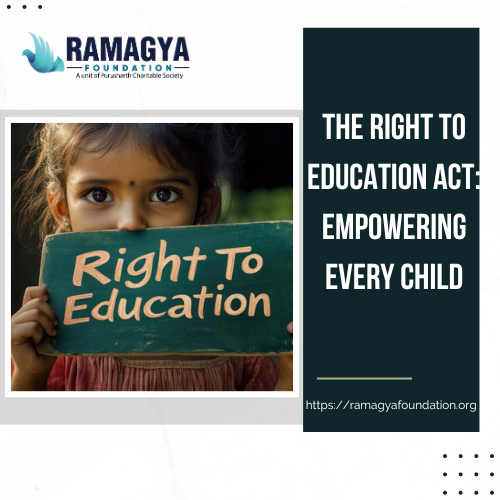It is commonly regarded as the basis of a prosperous and fulfilled life. It provides opportunities that empower individuals and change the way societies function. Due to numerous socioeconomic barriers, access to high-quality education has proven to be difficult for the majority of Indian youngsters.
The Right to Education Act of 2009 was introduced by the Indian government in response to this problem. Its goal is to guarantee that all children in the age range of 6 to 14 have the right to free and compulsory education.
Comprehending the Education Rights Act
A historic piece of law known as the Right to Education Act (RTE) promises a just and fair society in which every kid, regardless of background, has access to education. Let’s examine its most significant clauses:
- Free and Compulsory Schooling: RTE mandates that education for children aged 6 to 14 years old is completely free and mandatory. That means no kid should be denied entry to an educational institution due to financial hardship as it’s the responsibility of the state and local authorities to ensure that this provision is respected.
- Infrastructure and Facilities: Act stresses the importance of adequate infrastructure for schools. This includes playgrounds, classrooms, libraries, toilets, libraries safe drinking water, as well as other essential facilities that help create a positive learning environment.
- The Quality of Education: Right to Education Act 2009 insists on a high-quality education by laying out specific standards and norms for teaching curriculum, assessment, and methods. It is aimed at improving the learning outcomes of students through skilled teachers, child-friendly teaching techniques and continuous assessment.
- Equal and non-discrimination: The most fundamental principle of the Right to Education Act is the pursuit of equality in the field of education. It prohibits discrimination because of gender, caste or religion or situation, and ensures that every child has the same opportunities to grow and learn.
- Private Schools and Reservations: Act also stipulates that private schools have to reserve a certain amount of seats to children from poorer and economically disadvantaged sections. This policy is designed to help integrate children from different backgrounds into the education system.
- Monitoring and accountability: Right to Education Act 2009 establishes mechanisms for monitoring the effectiveness of its regulations and holds the authorities accountable for any infractions. It encourages participation of the community in the school’s management in order to guarantee transparency as well as effectiveness.
Impact of the RTE Act
Since its introduction it has been a significant step forward. RTE Act has brought about major changes in the educational environment in India:
- Increased Enrollment: It is believed that the Act has resulted in an increase of nearly 50% in the number of students enrolled in elementary schools throughout the nation particularly in marginalized communities who had previously been denied opportunities to learn.
- Reduction in Dropout Rates: By making education compulsory until 14 years of age and ensuring a comfortable education environment RTE can be credited with the reduction of dropout rates among school students.
- Female Empowerment: Right to Education Act 2009 has played an important role in closing gaps in gender equality, by increasing the number and quality of girls at schools.
- Improved Infrastructure: Many schools have seen improvements in infrastructure and facilities. These are vital to creating an environment that is conducive to learning.
Challenges and Road Ahead
Despite its successes, RTE faces several challenges in the effective implementation:
- Quality Disparities: There’s still differences regarding the standard of educational services offered in the economically and disadvantaged regions, typically lacking the proper facilities and teachers who are properly trained.
- Infrastructure Problems: Many schools struggle with insufficient infrastructure, especially in remote or tribal areas.
- Teacher shortages: There is an insufficient supply of educated and certified teachers, particularly in rural areas. This impacts how much education is offered to children.
- Budgetary Limitations: The proper resource allocation and funding remain a major issue, affecting the RTE’s implementation.
Ramagya Foundation: Bridging the Education Gap
In spite of this organizations such as Ramagya Foundation are playing a crucial role in changing the lives of children who are disadvantaged by providing education. It was established with a goal to provide every child with the power of education Ramagya Foundation focuses on:
- UNNATI programme: An after School Extra Program has been designed to promote multi-disciplinary arts and education. We have separated education according to age groups and educate children in accordance with their abilities and talents. At Unnati we support students who are enrolled in school or college as well as scholarship programs.
- Teachers Training Programmes: Understanding the crucial role played by teachers in shaping the minds of children, the foundation runs courses to help teachers improve their techniques and methods, while ensuring high-quality education.
- Foundation Engagement in Community: It works with local communities to increase awareness of educational importance, and encourages active involvement in the education journey of children.
- Advocates and Support for Policy: Ramagya Foundation is a proponent of policies that encourage equity and inclusion in education, working with government agencies and stakeholders to implement fundamental changes.
Conclusion: Ensuring Every Child’s Right to Education
In the end, it is clear that the Right to Education Act is an important step in the direction of building a more welcoming and well educated community in India. Although there are still challenges, the Act has established a solid base for the protection of every child’s right to an education.
Organisations such as the Ramagya Foundation exemplify the spirit of the Act through bridging gaps and providing children with a chance to be privileged by implementing education-related initiatives.
By combining our efforts and commitment to one another we can deliver on the promise of high-quality schooling for children of all ages, and pave the way to a better and more equal future.
